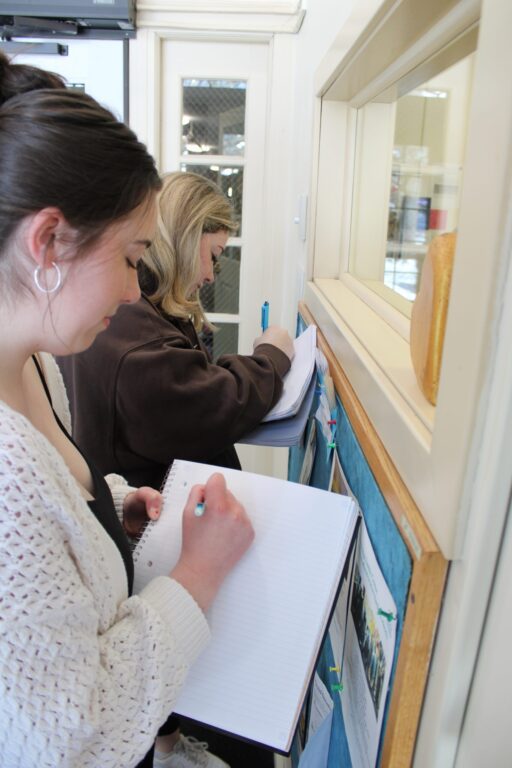Technology Boost Early Childhood Program Collaboration for USJ and SYC

Audio By Carbonatix

Katharine Ann Buck, Ph.D., associate professor and program director of Child Study at USJ. Courtesy of University of Saint Joseph
New technology at School for Young Children at the University of Saint Jospeh in West Hartford is an investment in next generation of early childhood educators.
Submitted
The School for Young Children (SYC) at the University of Saint Joseph serves as an important laboratory school for Child Study majors at USJ and students interested in pursuing USJ’s new concentration in Inclusive Early Childhood Education. Now, with a grant from the Connecticut Office of Early Childhood (OEC) and in partnership with Connecticut State Colleges and Universities (CSCU), SYC has undergone renovations that make it an even greater resource in the training of future early childhood educators at USJ.
The renovations, a part of the State of Connecticut’s Lab Schools Investment Initiative (LSII), include a redesign of SYC’s “college classroom” creating a space based on Universal Design for Learning and problem-based learning and a new state-of-the-art observation system that allows USJ students to observe and document the developmental progress of children in SYC’s classrooms.
USJ received $600,000 in grants to be used for the Initiative over four years. The funding for the grant comes from the federal American Rescue Plan Act (ARPA) to support lab school programs after the COVID-19 shutdown and help promote early childhood education and the professional development of childhood educators and care providers. USJ is now in the middle of the third year of the grant. SYC has used some of the funds to build a bathroom for young children adjacent to SYC’s Gross Motor Development area, and some of the money will be used to recarpet the hallways, college classroom, and offices at SYC. Twenty percent is earmarked for professional development for early childhood educators in the community through programming such as USJ’s annual Keefe-Bruyette Symposium. The funds also support SYC staff training and wellness initiatives, professional conference attendance, graduate assistant support, and classroom furnishings and supplies.

USJ students observe the children at the School for Young Children. Photo courtesy of the University of Saint Joseph
Communities of practice
Before the recent renovations, SYC’s college classroom consisted of a blackboard, a desk for faculty, and front-facing desks in a row. But according to TeachThought, an organization that promotes innovation in education, problem-based learning is best achieved through collaborative group work: “Students work with their peers to solve problems. That means the learning spaces must be organized in a way that supports collaboration – neat lines of forward-facing desks are the enemy.” Modeling that concept, the college classroom at SYC now features five collaborative worktables, each with a large monitor and a built-in power/data station into which students can plug their laptop computers.
“With the renovation of the SYC college classroom, students have the opportunity to collaborate and engage in ‘communities of practice’ as they train to become professionals in the field of early childhood who work as a team to develop and implement developmentally appropriate curricula that support children’s growth and development,” said Katharine Ann Buck, Ph.D., associate professor and program director of Child Study at USJ.
The new observation system installed in six of SYC’s early childhood classrooms allows students to listen in as they observe classroom activities through windows in the hallway outside of the classrooms. With the new technology, students can tune into different zones in the classrooms as they document children’s developmental progress, without interfering in classroom activities.
“With the newly installed state-of-the-art technology that allows for real-time, authentic, uninterrupted observations of children in the early childhood classroom, students have the opportunity to develop and refine key skills related to documentation, assessment, and interpretation—skills which are critical when entering the field of early childhood,” Buck explained.
“The new system allows us students to make thorough observations of the classrooms without being intrusive,” added Katherine Rigsby, a sophomore at USJ majoring in Child Study. “For example, as my class wanders the halls of SYC to peek into the classrooms, the observation system prevents children from feeling intimidated by a large crowd of people coming into their space while we are trying to learn.”
With plans to get her Elementary Education license, Rigsby was among the first group of students to begin working in the newly renovated college classroom, and with the new observation system.
“I think the collaborative classroom setup is a great addition to the room,” she said. “The TV display systems allow for all students to have the lesson materials for that day easily visible. Especially in a field such as education that has such a dire need for new teachers, I think these renovations showcase USJ’s commitment to building a successful next generation of teachers.”
Like what you see here? Click here to subscribe to We-Ha’s newsletter so you’ll always be in the know about what’s happening in West Hartford! Click the blue button below to become a supporter of We-Ha.com and our efforts to continue producing quality journalism.



